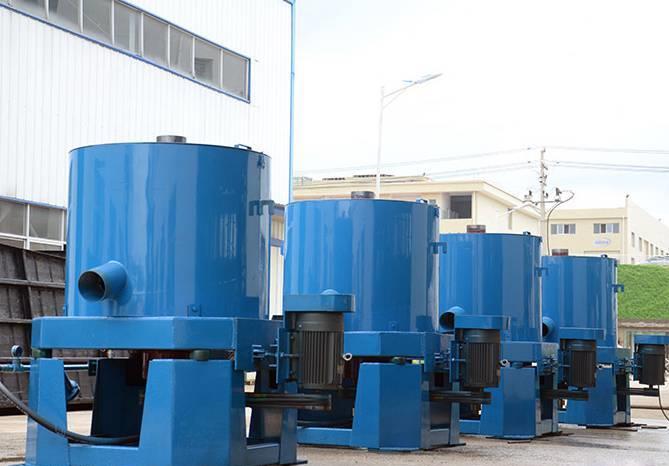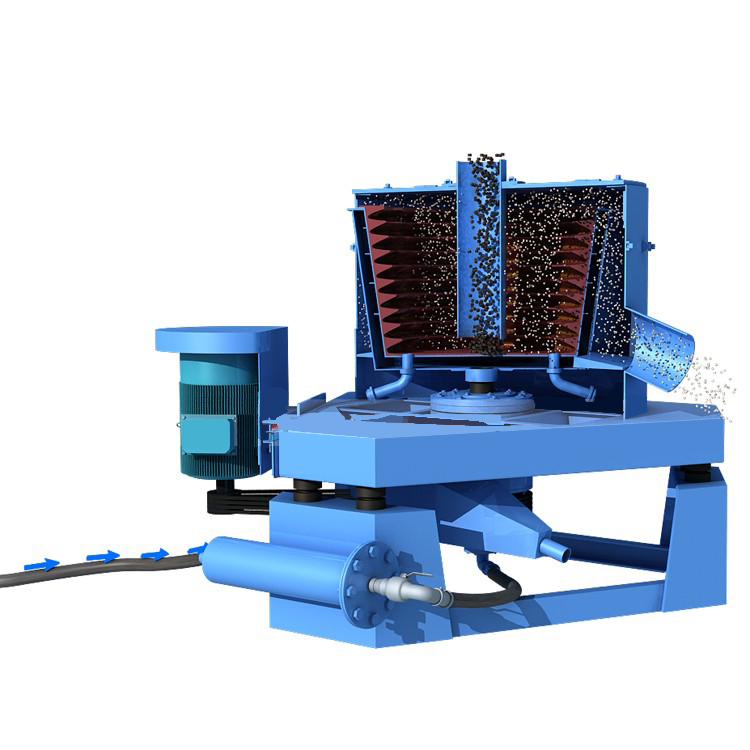Gold Centrifugal Concentrator
Gold centrifugal concentrator processing plant is kind centrifugal concentration equipment. It can be used not only for placer gold mining, but also for hard rock mining to recover the natural gold, replacing amalgamation. It is also used to recover gold from the old tailings.
-
Feeding Density0-50
-
Power0.75-18.5
-
Capacity0-120t/h
-
Feeding Size0-6

centrifugal concentrator is a relatively new type of gravity concentration apparatus. The machines utilise the principles of a centrifuge to enhance the gravitational force experienced by feed particles to effect separation based on particle density. The key components of the unit are a cone shaped "concentrate" bowl, rotated at high speed by an electric motor and a pressurized water jacket encompassing the bowl. Feed material, typically from a ball mill discharge or cyclone underflow bleed, is fed as a slurry toward the centre of the bowl from above. The feed slurry contacts the base plate of the vessel and due to its rotation, is thrust outward. The outer extremities of the concentrate bowl house a series of ribs and between each pair of ribs is a groove. During operation the lighter material flows upward over the grooves and heavy mineral particles (usually of economic value) become trapped within them. Pressurized water is injected through a series of tangential water inlets along the perimeter of each groove to maintain a fluidized bed of particles in which heavy mineral particles can be efficiently concentrated.
The main shaft is a hollow shaft, the pressurize backwash water come from the shaft, then goes into the separation unit, the water spray from holes to the gratings. During the process, the pressure of the water shall be 0.06-0.15MPa.
The slurry which is mixed with water and ore and sand will be injected to the mainframe. With the heavy centrifugal force, the slurry will be move upward along the cone body, the light particles will be extracted from the upper part of cone, then discharge through the tailing outlet. The heavy particles will be stay in the gratings of the inner layer.

Model | STLB20 | STLB30 | STLB60 | STLB80 | STLB100 |
Capacity | 0-0.6 | 2-3 | 8-12 | 40-45 | 80-120 |
Fluidization water Required(m³/h) | 2-3 | 3-5 | 7-10 | 30-36 | 60-80 |
Slurry Water Required(m³/h) | 1.5-4 | 5-7 | 8-12 | 40-45 | 70-100 |
Feeding Density(%) | 0-50 | 0-50 | 0-50 | 0-50 | 0-50 |
Feedign Size(mm) | 0-3 | 0-3 | 0-5 | 0-5 | 0-5 |
Concentrate Cleaning Up Cycle | Rock gold 1-3 hours,Placer gold 2-6 hours | ||||
Concentrate Weight(Kg) | 2 | 3-5 | 10-20 | 40-50 | 70-85 |
Power(kw) | 0.75 | 1.5 | 4 | 11 | 18.5 |
Dimensions | 914*700*900 | 1160*885*1165 | 1820*1450*1700 | 2520*1900*2020 | 2600*2000*2400 |
Weight(Kg) | 205 | 380 | 1100 | 2300 | 3200 |


 +86 166-3801-7614
+86 166-3801-7614



